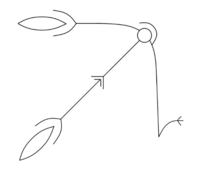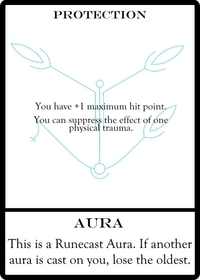Runecasting
From Falling Sky

Runecasting is a kind of magic that can be done by inscribing runes and invoking them. Learning to invoke runes can be done fairly easily and all characters can do it, but each runecaster can only hold a certain amount of a runic pattern in their mind at a time - this is known as their runic capacity.
- One runecaster must lead the invocation - they are the prime invoker for that invocation.
- A runecaster can only be the prime invoker for three invocations per event.
- The prime invoker must spend a mana crystal to start the invocation.
- Each invoker who is trained in Runecasting contributes their runic capacity to the invocation. One rune can be used for each point of runic capacity. An untrained character (one without the Runecaster trait) contributes only one point of runic capacity.
- It takes two minutes of appropriate roleplaying to complete an invocation. This often involves reciting the names of the runes, evoking similar concepts to what you’re trying to achieve, or mysterious chanting.
- Runecasting can be done under pressure, but if you stop or are struck by a weapon or call, the invocation is interrupted and must be started from the beginning. No resources are spent until an invocation is completed.
- It must be made clear exactly which runes are being used in the invocation, and in what orientation, by drawing out the runic inscription. This can be done on paper, or pieced together from pre-inscribed runes.
- Runecasting done in the field is much harder because of the less-than-ideal conditions and must be prepared in advance. (If you wish to use runecasting on a linear, please tell the refs in advance which inscription you will be using, or it won’t work.)
- Characters with the Careful Inscriber Trait can analyse an inscription during downtime. If the inscription is a valid one, they will receive a sheet with the analysis. The analysis can be used as the inscription, as it will have the inscription drawn on it.
- Once an inscription is successfully invoked, its effect is executed. Most, if not all, inscriptions turn one sort of power into another. Many of the inscriptions that are known convert mage's Mana Points into the effect in question. Attempting one of these invocations without sufficient mana points available among the invokers is usually successful, but has unusual magical effects on the casters. (OC: It is likely to give you one or more magical Trauma.) Some inscriptions will draw on different power sources; for example, this inscription is an example of blood magic, drawing on Hit Points rather than Mana Points to power the effect. Distribution of Mana Point or Hit Point loss from these rituals, or trauma from having insufficient supplies, will be adjudicated by the ref administering the Runecasting.
- Since many of the known inscriptions draw on Mana Points, and inscriptions are used to create new spells, being a mage and a runecaster is a common combination, but not by any means mandatory. Characters who are not a Mage have an effective mana pool of 1 for contributing to invocations, and expending it makes it hard to concentrate for a few minutes.
- Some invocations require a target. The prime invoker chooses the target when the invocation completes.
Once a rune becomes publicly known, all characters with the Runecasting skill may inscribe patterns with that rune in. There is a standing reward for anyone who brings a new rune to the Archives.
Each rune has a hexagonal bounding area. Reference images of the rune often include the bounding hexagon, but it does not need to be drawn in inscriptions of the rune. Each rune will touch the bounding hexagon in one or more places. A completed runic inscription must have each boundary line connected to another rune. It is a matter of much debate among runecasters whether the rune touches the edges or vertices of the bounding hexagon - characters with the Runecaster trait are encouraged to have a strong opinion on one side of the other of that debate.
Some runes are fairly well-understood, and there is a standard library of runic inscriptions that will work with little fuss. However, much of the art and lore of runecasting has been lost, and discovering new runes and new ways to combine them is a topic of intense interest.
Some notes on runecasting talk about "power runes" or "root runes" - it is assumed that these terms are related to how such an inscription draws its power.
There is a repository of all runic knowledge, kept by the Church of Enso. The Runic Repository is open to all, and any character may know the information in the Known Runes page.
Runecast Auras

Runecasting can produce Auras - temporary enchantments that affect a person. Most characters can only be affected by one Aura. If you are the subject of another Aura, your oldest Aura is removed.
Auras expire at the end of the next event that you attend - you can have an Aura cast on you at an Interactive and then take advantage of it on the following Linear.
Rune Lore Known Inscriptions
These are known inscriptions that work to achieve some effect.
Rune Lore In-Character Documents
These documents have been reproduced and copies are available from the Runic Repository at the Temple of Enso.
- Theory and Practice of Aura Enchantment by Ione Saldana
- Runic Structures for the Initiation of Mages by Avelthrim Thunderhost (only partial document recovered)